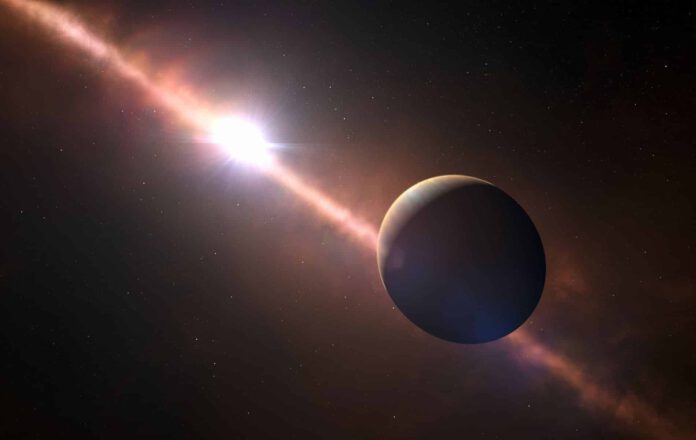
Cosmic Collision between Giant Asteroids Observed 63 Light Years Away
Recently, a massive collision occurred between giant asteroids about 63 light years from Earth. This cosmic event took place in Beta Pictoris, a neighboring planetary system known for its young age and tumultuous planet formation processes. These insights have been provided by the exceptional capabilities of the James Webb Space Telescope.
Insight into Early Planet Formation
The observations offer a unique glimpse into the early stages of planet formation. It’s essentially a view of how our own solar system once formed. “Beta Pictoris is at an age where planet formation in the zone for rocky planets is still ongoing. Giant asteroids crash into each other. What we are seeing here is, in fact, how rocky planets such as Earth and other space objects are forming in real-time,” says scientist Christine Chen from Johns Hopkins University in the United States.
Rocky vs. Gas Planets
Gas planets are primarily composed of gas and are significantly larger than rocky planets. They also tend to form earlier. In our solar system, Jupiter, Saturn, Uranus, and Neptune are gas planets. Conversely, a rocky planet is mainly composed of iron and rock. Earth is the most well-known example, but Mars, Venus, and Mercury are also rocky planets.
Thermal Radiation from Dust Particles
Chen’s team compared new data from James Webb with observations from the Spitzer Space Telescope from 2004 and 2005. They discovered distinct changes in the energy signatures of dust particles around Beta Pictoris. Something very significant must have occurred in the last twenty years to account for these detailed measurements from Webb. The astronomers scrutinized the composition and size of the dust grains in the specific area previously analyzed by Spitzer, focusing on the heat emitted by crystalline silicates – minerals commonly found around young stars, but also on Earth and other celestial bodies. Despite extensive searches, they found no trace of the particles that were clearly observed in 2004 and 2005.
Witnessing a Rare Cosmic Event
The conclusion, therefore, is that about twenty years ago, a cataclysmic collision happened between asteroids and other objects, pulverizing them into fine dust particles, smaller than pollen grains or powdered sugar. “We assume this is the dust we originally saw in the Spitzer data from 2004 and 2005,” Chen explains. “Considering the new Webb data, our best explanation is that we have been witnessing the aftermath of a rare, cataclysmic event between large celestial bodies. The mega collision provides a totally different perspective on how this planetary system is structured.”
Astronomical Insights
The new data clarify that the dust particles are no longer detectable because they have spread to the edges of the planetary system under the influence of the central star’s radiation, Chen stated. Initially, the fine dust grains near the star warmed up and emitted thermal radiation that Spitzer’s instruments could pick up. The dust particles farther from the star have significantly cooled down and, therefore, no longer emit the same thermal radiation. The Webb observations show that the dust disappeared and was not replaced.
Ancient Gas Giants
Beta Pictoris is located approximately 63 light years away from us. Astronomers have long been highly interested in this neighboring planetary system. At just 20 million years old – compared to our 4.5 billion-year-old solar system – Beta Pictoris is in a key developmental stage where giant gas planets have formed, but terrestrial planets are likely still developing. It has at least two known gas giants, Beta Pic b and c, which also influence the surrounding dust and debris.
Exploring Planetary Formation
“The question we are trying to answer is whether this entire process of forming terrestrial and giant planets is common or rather rare. And then there’s the even more fundamental question: Are there many planetary systems that resemble ours? And how special is our solar system?” asks researcher Kadin Worthen. “We are essentially trying to understand how unusual or average we are.”
Revealing the Unknown
The new insights underscore the unparalleled capability of the Webb telescope to reveal the complexity of exoplanets and star systems, the researchers say. The images provide important clues about the architecture of other planetary systems and the extent to which they resemble our own. How do the early stages and cosmic turbulence influence the atmosphere, water content, and other critical aspects of habitability of planets? With Webb, astronomers hope to learn more about this in the coming years.
“Most discoveries via James Webb come from things that the telescope has directly detected,” the team notes. “In this case, the story is slightly different because our results stem from what Webb did not see.”











